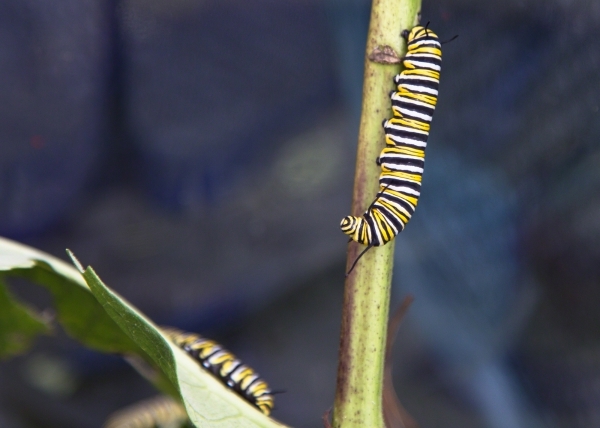VERNON — In the last few decades, Peggy Farabaugh noticed a distinct decline in the monarch butterfly population. After learning why, she decided to do something about it.
During the first week of September, the back deck of Vermont Woods Studios, the Vernon business she owns with her husband, Ken, became a sort of caterpillar hatchery.
“We have 15 cocoons in mesh hampers, and some on the milkweed plants in the field” behind the building, she said. The pupae should hatch into monarch butterflies by mid-month.
“This is the first year we're hatching them,” she said. Farabaugh got the larvae - “they arrive the size of a grain of rice,” she said - from Chip Taylor, director of Monarch Watch (monarchwatch.org), based at the University of Kansas.
Fifteen years ago, Farabaugh and her two young children were walking in the woods when they discovered what she described as “this weird looking worm-caterpillar guy on this weed."
They brought it to their neighbor, who identified it as a monarch caterpillar. She told Farabaugh and her sons how the caterpillar transforms itself into a beautiful monarch butterfly.
“We were fascinated,” she said.
They started looking for monarch caterpillars to raise at home and watch the process.
A few years later, when Farabaugh's sons began kindergarten in Vernon, their teacher, Carol Richardson, raised monarchs in “a huge terrarium” in her classroom.
Farabaugh said Richardson was increasingly having a difficult time finding them, so she and her sons searched the area's fields and woods for caterpillars to bring to their former teacher.
“In the last five or 10 years, we couldn't find them, either,” Farabaugh said, “and that was really sad."
“We used to find caterpillars lined up on the [side of the] road in milkweed near corn fields,” Farabaugh said. “Now, there are none."
“I wanted to know why, so I went online,” she said.
She learned a few reasons why monarchs were disappearing.
The problem
On the Monarch Watch blog, Taylor wrote that “the overuse of herbicides along roadsides and elsewhere is turning diverse areas that support monarchs, pollinators, and other wildlife into grass-filled landscapes that support few species. The adoption of genetically modified soybeans and corn have further reduced monarch habitat.”
When farmers use herbicides such as RoundUp to eradicate other plants near corn fields, Farabaugh said, it kills off milkweed, which is the main food source for monarch caterpillars.
The caterpillars eat the milkweed leaves, and then attach themselves to the leaves to spin their delicate, pale-green chrysalis. After about two weeks, the butterfly emerges.
The deforestation in Mexico and Central America has also contributed to a figure Farabaugh cited: “there's been a 90 percent decline in the monarch population,” she said.
“There's a special tree called oyamel where monarchs overwinter,” Farabaugh said. The Abies religiosa, a high-altitude evergreen native to central and southern Mexico and western Guatemala, is the preferred hibernation habitat for the monarch butterfly. It is rapidly disappearing.
“We've taken out their milkweed up here, and taken out their oyamel down there,” she said. “They're in a desperate situation."
Why should anyone care if some butterflies become scarce?
Annie Dintino, who works in marketing for Vermont Woods Studios and volunteers with Farabaugh's monarch restoration project, answered bluntly, “They're pollinators. They help you get your food."
“Nature took probably 50 million years to evolve this incredibly amazing animal, and we're taking 20 years to destroy it,” Farabaugh added.
The solution
“The first thing we have to do is plant new milkweed,” Farabaugh said, “because we have to restore their habitat."
About a year ago, Farabaugh went searching for milkweed pods from which to harvest the seeds.
She found a field owned by David Barrie. It was “covered in milkweed,” she said.
Farabaugh said she called Barrie at his real estate office, and “it was the weirdest request he said he had ever had.”
But, Barrie invited her to “take all the milkweed you want, please."
“We got as much as we could,” she said, and with the help of volunteers and her furniture company's employees, they separated the seeds from the approximately 1,000 pods they collected.
They found about 15 people to take seeds and plant them in gardens, yards, and fields. “We gave the rest to a seed bank,” Farabaugh said.
“Only one in 100 seeds is likely to take, but you do the best you can,” she said.
Maintaining existing milkweed is also a goal, she said.
“We have to have the town road crews on-board,” she said, noting if towns and individuals stopped mowing the entirety of highway medians, roadsides, and fields, the milkweed could thrive. And with it, the monarch butterfly.
Farabaugh said if mowers could wait until autumn, it would give the monarchs time to cocoon and hatch. “They should all be out and emerged and flown to start their journey south by mid-October,” she said.
“We should have a 'Hell no, we won't mow!' campaign,” she said. “That would help tremendously."
Some of the people who took milkweed seeds last year came back this year when Farabaugh distributed the monarch caterpillars she ordered from Taylor, she said.
She said “a number of schoolteachers” came to get caterpillars and milkweed seeds for their classrooms, too.
“We just gave the last caterpillars away,” she said. Taylor sent her “about 50,” and “the mortality rate is 50 percent,” Farabaugh said.
She hopes to bring in more volunteers next year, she said.
Meanwhile, she said she still has milkweed seeds.
“We always invite people” to come and get them, including classroom groups, she said.
“I'll drop what I'm doing” if someone visits Vermont Woods Studios asking for the seeds, Farabaugh said.
